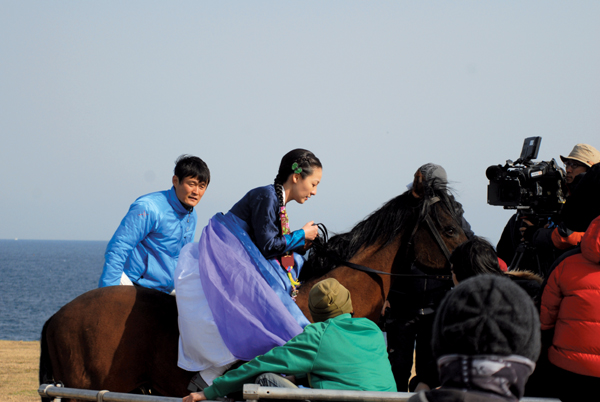
After a few weeks of finicky winter weather, conditions were finally favorable for shooting an outdoor scene for the drama “Kuhsang [Great Merchant] Kim Man Deok.” On a mild afternoon in early March just east of Pyoseon Beach, the sun was low on the horizon producing crisp shadows and squinting eyes, and a strong breeze tossed around the traditional robes worn by the actors. All the elements were in place for filming the dramatic transition scene where the young Kim Man Deok fades out and is re-placed by her adult counterpart.
“The weather has not been very cooperative,” said Lee Je Hoon, assistant director of the drama. “We’ve had to shoot in harsh conditions and there have been some cancellations. Fortunately the weather is good today!”
The young Kim Man Deok, played by up-and-coming actress Shim Eun Kyung, climbed atop a fake horse resting in the back of a pickup truck. As the horse began to rock, resembling some-thing between a child’s ride at the mall and a bucking bull ride at a country-western bar, the young actress laughed in surprise and held on tightly. With olle trekkers watching curiously in the distance, the truck drove around the grassy plain while the drama’s main actor, Han Jae Suk, followed closely behind perched comfortably atop a real horse.
Moments after the scene was captured, well known actress Lee Mi Yeon arrived by private car to avoid standing around in the wind. As she made her way to the pickup truck, Shim hopped down and scurried away, her role in the show now complete. Lee is best known for her roles in “Empress Myung Sung” (2001), “Indian
Summer” (2001), and “No. 3” (1997), and was crowned Best Actress at the 2000 Blue Dragon Awards for her role in “Pisces”.
“She is sort of like a Gwyneth Paltrow,” said Kim Hae Ok, an English teacher, when asked to compare Lee’s level of fame to a Western actress. “She’s seen as a pure character.”

Filming began in late February, with the first episode airing on March 6. KBS chose the story of the historical figure Kim Man Deok in an effort to put more educational material on the air. Her story is well known by people on Jeju, but much less so on the mainland.
“Kim Man Deok has a very unique personality. Not only is the story educational, but she makes an interesting character for a drama,” Lee Je Hoon said.
Kim Man Deok was born on Jeju Island during the King Jeongjo era, which spanned from 1776 to 1800. Losing both her parents at a young age, she began working as a gisaeng, an artistic female performer similar to a Japanese geisha. Kim Man Deok was very popular and became friends with many high ranking public officials.
“She could have made a fortune in the entertainment business, but Kim Man Deok envisioned a different life for herself,” said Kim Jeong Geum, a middle school history teacher.
Because of Kim Man Deok’s high standing with the political figures of the time, she was given permission to begin working as a merchant. Truly a Kim-of-all-trades, she quickly became successful in her new endeavor and was able to set aside a small fortune. Some time later, poor economic times hit Jeju and famine was wide-spread. Kim Man Deok spent her savings to provide rice for the people, saving countless lives.
Up in Seoul, the king heard of Kim Man Deok’s selfless act and was impressed. He sent a message that he would grant her one wish. Not desiring anything material, Kim Man Deok decided to use the opportunity to leave Jeju and see other parts of Korea. She became the first woman to ever receive permission to visit the palace in Seoul and meet the king.
Taking place two centuries ago, the story of Kim Man Deok provokes some interesting challenges for the directors. According to Lee Je Hoon, it is quite difficult reproducing authentic looking clothing and cosmetics, as well as using the correct language and dialect of the time.
“Critics are very harsh about the accuracy of historical dramas,” Lee said.
Kim Man Deok’s legacy is very much alive in Korea today and a memorial to her can be found on Sarabong Oreum. All Jeju students learn her story in elementary school, and recently a chapter on her has been added to grade one middle school textbooks through-out Korea.
“Compassion, sympathy, sharing ... Man Deok possessed many admirable character traits from which we can learn,” Kim Jeong Geum said.
The historical mini-drama can be seen on KBS1 on Saturdays and Sundays following the evening news (around 9:40 p.m.). Non-Korean speakers can be entertained while learning a bit of Jeju history by watching with English subtitles on the drama site mysoju.com.
ⓒ Jeju Weekly (http://www.jejuweekly.com) All rights reserved.

